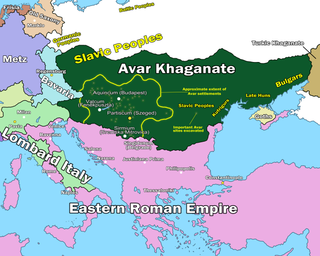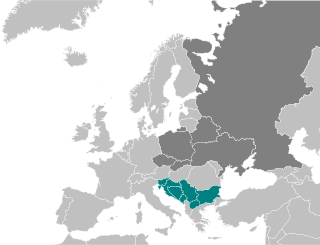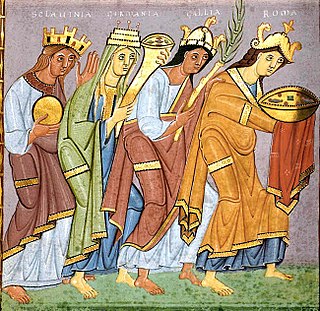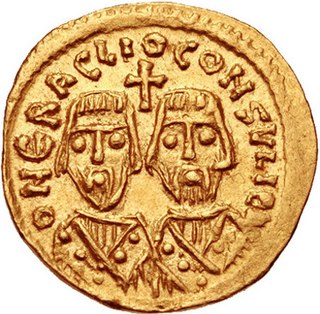Related Research Articles

The Pannonian Avars were an alliance of several groups of Eurasian nomads of various origins. The peoples were also known as the Obri in chronicles of Rus, the Abaroi or Varchonitai, or Pseudo-Avars in Byzantine sources, and the Apar to the Göktürks. They established the Avar Khaganate, which spanned the Pannonian Basin and considerable areas of Central and Eastern Europe from the late 6th to the early 9th century.

Glad was the ruler of Banat at the time of the Hungarian conquest of the Carpathian Basin around 900 AD, according to the Gesta Hungarorum. The Gesta, which was written by an author known in modern scholarship as Anonymus in the second half of the 12th century or in the early 13th century, is the earliest extant Hungarian chronicle. The Gesta did not refer to the enemies of the conquering Hungarians, who had been mentioned in earlier annals and chronicles, but wrote of a dozen persons, including Glad, who are unknown from other primary sources of the Hungarian Conquest. Therefore, modern historians debate whether Glad was an actual enemy of the conquerors or only a "fictitious person" made up by Anonymus. In Romanian historiography, based on the mention by Anonymus some 300 years later, Glad is described as one of the three Romanian dukes who ruled a historical region of present-day Romania in the early 10th century.

South Slavs are Slavic people who speak South Slavic languages and inhabit a contiguous region of Southeast Europe comprising the eastern Alps and the Balkan Peninsula. Geographically separated from the West Slavs and East Slavs by Austria, Hungary, Romania, and the Black Sea, the South Slavs today include Bosniaks, Bulgarians, Croats, Macedonians, Montenegrins, Serbs and Slovenes.

Pannonia Secunda was one of the provinces of the Roman Empire. It was formed in 296 AD, during the reign of Emperor Diocletian. The capital of the province was Sirmium. Pannonia Secunda comprised parts of present-day Serbia, Croatia, and Bosnia and Herzegovina.

The Sclaveni or Sklabenoi were early Slavic tribes that raided, invaded and settled in the Balkans in the Early Middle Ages and eventually became one of the progenitors of modern South Slavs. They were mentioned by early Byzantine chroniclers as barbarians having appeared at the Byzantine borders along with the Antes, another Slavic group. The Sclaveni were differentiated from the Antes and Wends ; however, they were described as kin. Eventually, most South Slavic tribes accepted Byzantine or Frankish suzerainty, and came under their cultural influences and Chalcedonian Christianity. The term was widely used as a general catch-all term until the emergence of separate tribal names by the 10th century.

Heraclius the Elder was a Byzantine Roman general and the father of Byzantine Roman emperor Heraclius. Heraclius the Elder distinguished himself in the war against the Sassanid Persians in the 580s. As a subordinate general, Heraclius served under the command of Philippicus during the Battle of Solachon and possibly served under Comentiolus during the Battle of Sisarbanon. Circa 595, Heraclius the Elder is mentioned as a magister militum per Armeniam sent by Emperor Maurice to quell an Armenian rebellion led by Samuel Vahewuni and Atat Khorkhoruni. Circa 600, he was appointed as the Exarch of Africa and in 608, he rebelled with his son against the usurper Phocas. Using North Africa as a base, the younger Heraclius managed to overthrow Phocas, beginning the Heraclian dynasty, which would rule Byzantium for a century. Heraclius the Elder died soon after receiving news of his son's accession to the Byzantine throne.

The Diocese of Dacia was a diocese of the later Roman Empire, in the area of modern western Bulgaria, central Serbia, Montenegro, Kosovo, northern Albania and northern North Macedonia. It was subordinate to the Praetorian prefecture of Illyricum. Its capital was at Serdica.
Petrus (Greek: Πέτρος, Petros, also known as Peter in English was a brother of the Byzantine Emperor Maurice.
Maurice's Balkan campaigns were a series of military expeditions conducted by Roman Emperor Maurice in an attempt to defend the Balkan provinces of the Roman Empire from the Avars and the South Slavs. Maurice was the only East Roman emperor, other than Anastasius I, who did his best to implement determined Balkan policies during Late Antiquity by paying adequate attention to the safety of the northern frontier against barbarian incursions. During the second half of his reign, the Balkan campaigns were the main focus of Maurice's foreign policies, as a favourable peace treaty with Persian Empire in 591 enabled him to shift his experienced troops from the Persian front to the region. The refocusing of Roman efforts soon paid off: the frequent Roman failures before 591 were succeeded by a string of successes afterwards.

The Antes or Antae were an early Slavic tribal polity of the 6th century CE. They lived on the lower Danube River, in the northwestern Black Sea region, and in the regions around the Don River. Scholars commonly associate the Antes with the archaeological Penkovka culture.

Much of the territory of the modern state of Serbia was part of the Roman Empire and later the Eastern Roman Empire. In particular, the region of Central Serbia was under Roman rule for about 800 years, starting from the 1st century BC, interrupted by the arrival of the Slavs into the Balkans during the 6th century, but continued after fall of the First Bulgarian Empire in the early 11th century and permanently ended with the rise of the Second Bulgarian Empire in the late 12th century. The territories were administratively divided into the provinces of Moesia, Pannonia and Dardania. Moesia Superior roughly corresponds to modern Serbia proper; Pannonia Inferior included the eastern part of Serbia proper; Dardania included the western part of Serbia proper. After its reconquest from the Bulgarians by Emperor Basil II in 1018, it was reorganized into the Theme of Bulgaria.

The early Slavs were speakers of Indo-European dialects who lived during the Migration Period and the Early Middle Ages in Central, Eastern and Southeast Europe and established the foundations for the Slavic nations through the Slavic states of the Early and High Middle Ages. The Slavs' original homeland is still a matter of debate due to a lack of historical records; however, scholars generally place it in Eastern Europe, with Polesia being the most commonly accepted location.
Priscus or Priskos was a leading Eastern Roman general during the reigns of the Byzantine emperors Maurice, Phocas and Heraclius. Priscus comes across as an effective and capable military leader, although the contemporary sources are markedly biased in his favour. Under Maurice, he distinguished himself in the campaigns against the Avars and their Slavic allies in the Balkans. Absent from the capital at the time of Maurice's overthrow and murder by Phocas, he was one of the few of Maurice's senior aides who were able to survive unharmed into the new regime, remaining in high office and even marrying the new emperor's daughter. Priscus, however, also negotiated with and assisted Heraclius in the overthrow of Phocas, and was entrusted with command against the Persians in 611–612. After the failure of this campaign, he was dismissed and tonsured. He died shortly after.
Daurentius or Dauritas was a Slavic (Sclaveni) chieftain in the 6th century. He seems to have been the supreme chief of a Slavic tribal confederation, which "fellow chiefs" were or subordinated to him, or of the similar tribal rank and status as Daurentius.
Ardagast or Radogost was a 6th-century Sclaveni brigadier (chieftain), alongside Peiragastus/Peragastus (594), under rex Musokios, mentioned by Theophylact Simocatta.
Chilbudius or Chilbuldius was a Byzantine general, holding the rank of magister militum per Thracias in the early 530s. He was apparently killed in battle c. 533, but an impostor claimed his identity c. 545–546. The only source for both men is Procopius.
Alexander was a Byzantine military officer, active in the reign of Maurice. He is styled a taxiarch in the accounts of Theophylact Simocatta. He is known for his part in campaigns against the Sclaveni.

The Battles of Viminacium were a series of three battles fought against the Avars by the Eastern Roman Empire. They were decisive Roman successes, which were followed by an invasion of Pannonia.

Moesia Prima was a frontier province of the Late Roman Empire, situated in the central parts of present-day Serbia, along the south bank of the Danube River. Provincial capital was Viminacium, near modern Kostolac in Serbia).

The Avar–Byzantine wars were a series of conflicts between the Byzantine Empire and the Avar Khaganate. The conflicts were initiated in 568, after the Avars arrived in Pannonia, and claimed all the former land of the Gepids and Lombards as their own. This led to an unsuccessful attempt to seize the city of Sirmium from Byzantium, which had previously retaken it from the Gepids. Most subsequent conflicts came as a result of raids by the Avars, or their subject Slavs, into the Balkan provinces of the Byzantine Empire.
References
- ^ His name is transliterated as Musokios, Musukios or Musocius [11] from the works by Byzantine historian Menander Protector (l. mid-6th century). Some scholars saw Slavic name as Mužok. [12]
- ^
- ↑ Curta 2001, p. 327–328, 331.
- 1 2 Živković 2008, pp. 47–49.
- ↑ Curta 2001, p. 58, 318, 321, 344.
- ↑ Kardaras 2017, pp. 252–253.
- ↑ Živković 2008, p. 56.
- ↑ Curta 2001, p. 101.
- 1 2 Živković 2008, pp. 49–50.
- ↑ Curta 2001, p. 102.
- ↑ Živković 2008, p. 53, 64–66.
- ↑ Curta 2001, p. 102, 322.
- ↑ Daniel Ziemann, Böhlau Verlag Köln Weimar, 2007, Vom Wandervolk zur Grossmacht:die Entstehung Bulgariens im frühen Mittelalter (7.-9. Jahrhundert) page 116
- ↑ Pavel Jozef Šafárik, Über die Abkunft der Slawen nach Lorenz Surowiecki (1828), Buda, page 25
- ↑ Jan Filip, International Union of Prehistoric and Protohistoric Sciences, Actes du VIIe Congrés International des Sciences Prehistoriques et Protohistoriques, Prague 21-27 août 1966 , Institut d'Archéologie de l'Académie Tchécoslavaque des Sciences à Prague, 1970, page 1085
- ↑ page 82
Sources
- J B Bury, History of the Later Roman Empire from Arcadius to Irene, Vol 2, p. 129, 130 and 172
- Curta, Florin (2001). The Making of the Slavs: History and Archaeology of the Lower Danube Region, c.500–700. Cembridge University. ISBN 9781139428880.
- Kardaras, Georgios (2017). "A re-approach of Procopius' ethnographic account on the early Slavs". Byzantina Symmeikta. 27: 239–257. doi:10.12681/byzsym.10407.
- Simocatta, Theophylact (1997) [1986]. Michael Whitby, Mary Whitby (ed.). The History of Theophylact Simocatta: An English Translation with Introduction and Notes (PDF). New York: Oxford University Press. ISBN 0-19-822799-X.
- Živković, Tibor (2008). Forging unity: The South Slavs between East and West 550-1150. Belgrade: The Institute of History, Čigoja štampa. ISBN 9788675585732.